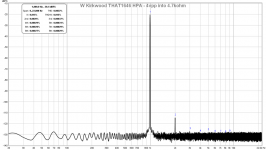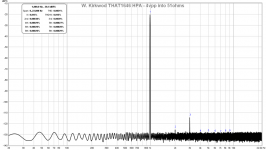Dan,
If you wanted low impedance but wanted to preserve the existing harmonics, you could use single ended (say a mosfet with a largish 100mH inductor like a tube to double the efficiency) or even Pass SE amps. Otherwise, you'd use a PP output stage, like any of the amps on this forum (Honey Badger, X hex, etc) with a choice to use Class AB or Class A.
Then you'd have a full on audio power amplifier, taking the brief to its conclusion. But this was simply an attempt to set up a gain block for use as a part of a whole amp.
Kean, thanks a lot, I understand now....... good points, all of them, but I've not found CCS impedance issues limiting open loop gain. In truth, I've always tried to keep loop gain down so compensation is a bit easier and sound is more natural.
Bimo,
sama sama....... terima kasih atas Emprit, yang terbaik.......
Ciao,
Hugh
If you wanted low impedance but wanted to preserve the existing harmonics, you could use single ended (say a mosfet with a largish 100mH inductor like a tube to double the efficiency) or even Pass SE amps. Otherwise, you'd use a PP output stage, like any of the amps on this forum (Honey Badger, X hex, etc) with a choice to use Class AB or Class A.
Then you'd have a full on audio power amplifier, taking the brief to its conclusion. But this was simply an attempt to set up a gain block for use as a part of a whole amp.
Kean, thanks a lot, I understand now....... good points, all of them, but I've not found CCS impedance issues limiting open loop gain. In truth, I've always tried to keep loop gain down so compensation is a bit easier and sound is more natural.
Bimo,
sama sama....... terima kasih atas Emprit, yang terbaik.......
Ciao,
Hugh
Last edited:
Member
Joined 2009
Paid Member
Yes, most certainly....who needs op amps ?
yeah ! AKSA buries Burson

I suspect High has many more tricks up his sleeve....
Last edited:
For lowish I mean 1k or so, certainly 5k.This was designed to be a preamp - so not for low impedance loads. Otherwise it would be a headphone amp. Are you talking 1kohm or 120ohms?
Yes.Although adding a pair of power transistors either in push pull, or SE Class A could make this a low impedance amp.
Yes.Dan,
If you wanted low impedance but wanted to preserve the existing harmonics, you could use single ended (say a mosfet with a largish 100mH inductor like a tube to double the efficiency) or even Pass SE amps. Otherwise, you'd use a PP output stage, like any of the amps on this forum (Honey Badger, X hex, etc) with a choice to use Class AB or Class A.
Understood.Then you'd have a full on audio power amplifier, taking the brief to its conclusion. But this was simply an attempt to set up a gain block for use as a part of a whole amp.
Heresy....according to the opamp camp.Kean,......good points, all of them, but I've not found CCS impedance issues limiting open loop gain. In truth, I've always tried to keep loop gain down so compensation is a bit easier and sound is more natural.
Dan.
Yes, heresy, and I've never understood why every one believes the THD wars....... 
Some say a very good SET amp does up to 1-2% and yet it's the best......
Others say a JLH SS Class A in quasi and 0.05% THD is very good too......
But I say we are chasing the wrong numbers based entirely of a real world, subjective listening experience. How do we measure depth of image, and engagement of the music? Bah, can't measure it, doesn't exist!! Hmmmm.........
Bah, can't measure it, doesn't exist!! Hmmmm......... 
We need to look forward beyond the THD, a gross sum of tiny misdemeanors, and examine the proportions of the harmonics...... and further more, how the amp manages intermodulation........
Nasty 30C day in Melbourne, not enjoying it.
HD
Some say a very good SET amp does up to 1-2% and yet it's the best......
Others say a JLH SS Class A in quasi and 0.05% THD is very good too......
But I say we are chasing the wrong numbers based entirely of a real world, subjective listening experience. How do we measure depth of image, and engagement of the music?
We need to look forward beyond the THD, a gross sum of tiny misdemeanors, and examine the proportions of the harmonics...... and further more, how the amp manages intermodulation........
Nasty 30C day in Melbourne, not enjoying it.

HD
Member
Joined 2009
Paid Member
@Max Headroom: Hang tight and I will measure against 4.7k load. I think 1k is too low.
@Aksa: what frequencies should I measure intermodulation distortion at? 100Hz and 5kHz?
Btw, 92F is nothing. It's a swamp here in the summer in DC, sometimes 98F (38C) and high humidity. Why the Founding Fathers would choose a swamp to put the Nation's Capitol in - I don't know. It's 41F (5C) now and falling.
@Aksa: what frequencies should I measure intermodulation distortion at? 100Hz and 5kHz?
Btw, 92F is nothing. It's a swamp here in the summer in DC, sometimes 98F (38C) and high humidity. Why the Founding Fathers would choose a swamp to put the Nation's Capitol in - I don't know. It's 41F (5C) now and falling.
Last edited:
Yes, Bigun, I would LOVE the cold right now...... you are a Brit, with all the madness and walking out into the bright mid-afternoon Sun!
The preamp would do about 44Vpp, so assuming 22Vp and 2.5k load we have 8.8mA load current which is reasonably within the remit of the 12mA CCS, leaving 3.2mA, more than to supply the VAS 1.5mA. So that would be about the max.
If you want to run a heavier load, say 32R, a typical value for a low Z headphone, you'd probably replace the output buffer with a mosfet, and run it at an undistorted 4Vpeak, which would be only 125mA. So you'd run the mosfet at around 130mA for this, and since the buffer is driving a gate, it's easy to drive. In fact, you could drop the buffer, directly connect it to the gate. I'd suggest something like a IRFP610.
Cheers,
HD
The preamp would do about 44Vpp, so assuming 22Vp and 2.5k load we have 8.8mA load current which is reasonably within the remit of the 12mA CCS, leaving 3.2mA, more than to supply the VAS 1.5mA. So that would be about the max.
If you want to run a heavier load, say 32R, a typical value for a low Z headphone, you'd probably replace the output buffer with a mosfet, and run it at an undistorted 4Vpeak, which would be only 125mA. So you'd run the mosfet at around 130mA for this, and since the buffer is driving a gate, it's easy to drive. In fact, you could drop the buffer, directly connect it to the gate. I'd suggest something like a IRFP610.
Cheers,
HD
That BSP129 can handle 300mA so in theory, could we out a 2SA1837 and run bias at 125mA through it? Keeping the buffer and this might be a slick headphone amp? Would need some big heatsinks though, or drop the Vcc otherwise that's 3w dissipation per active. Probably Vcc of 24v would be more than sufficient. But resistor network may need to be revamped.
Lower impedance and IMD measurements
I installed a 4k7 resistor, and that, coupled with a voltage divider for the input resulted in a net 3.4kohm load.
Here is 4vpp into 3.4kohms, I adjusted the gain on the audio interface a bit but distortion is still pretty low, around noise floor of measurement setup:
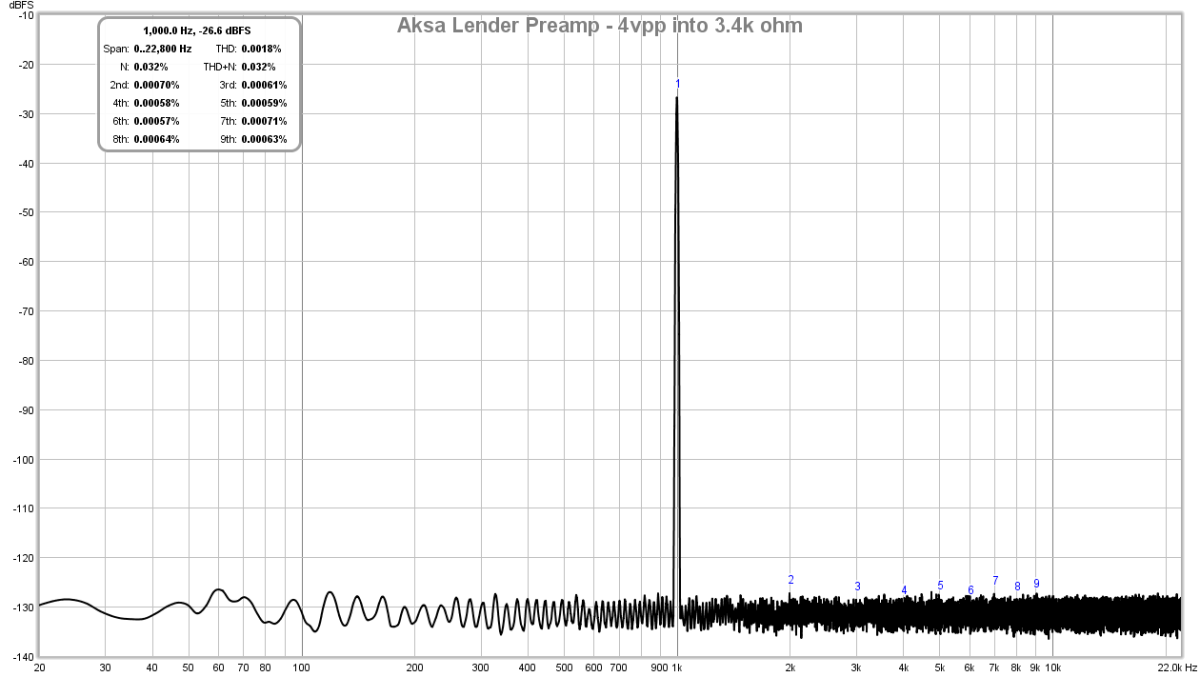
Here is 20vpp into 3.4kohms, it seems 3rd order harmonic distortion increases relative to 2nd order at this loading, but still a decent result that would probably sound quite good still:
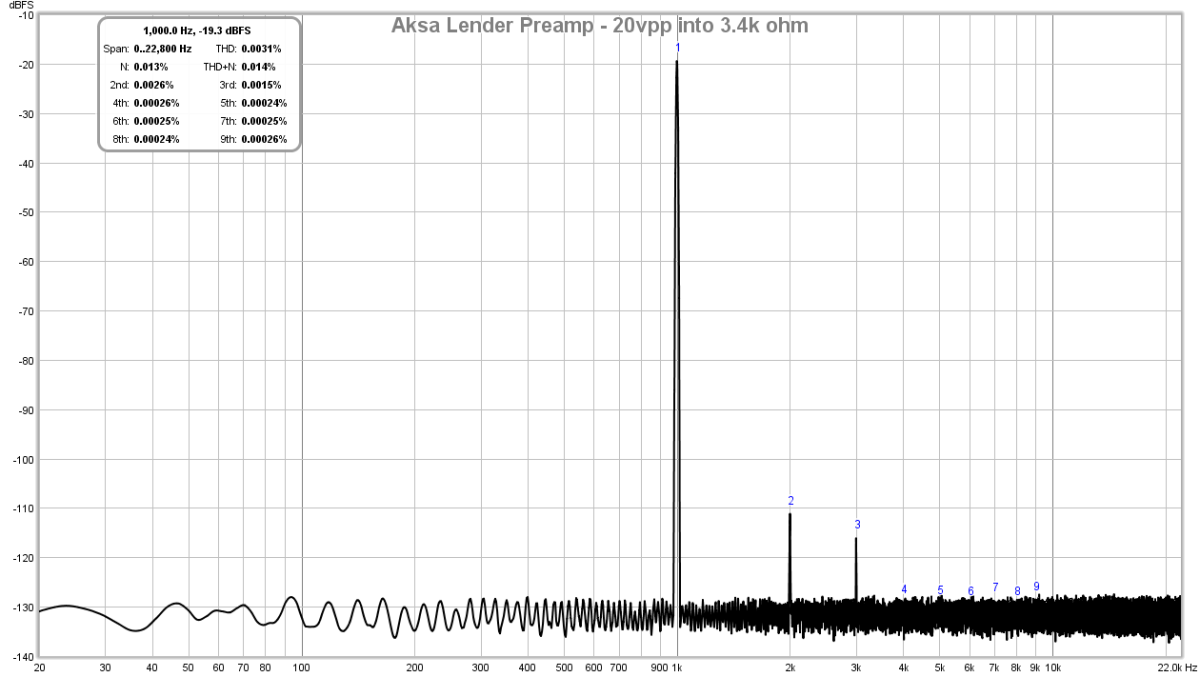
Here is 36vpp into 3.4kohms, 2nd and 3rd order about the same (some people like this sound as it has more bite), and any higher in amplitude, and it starts clipping:
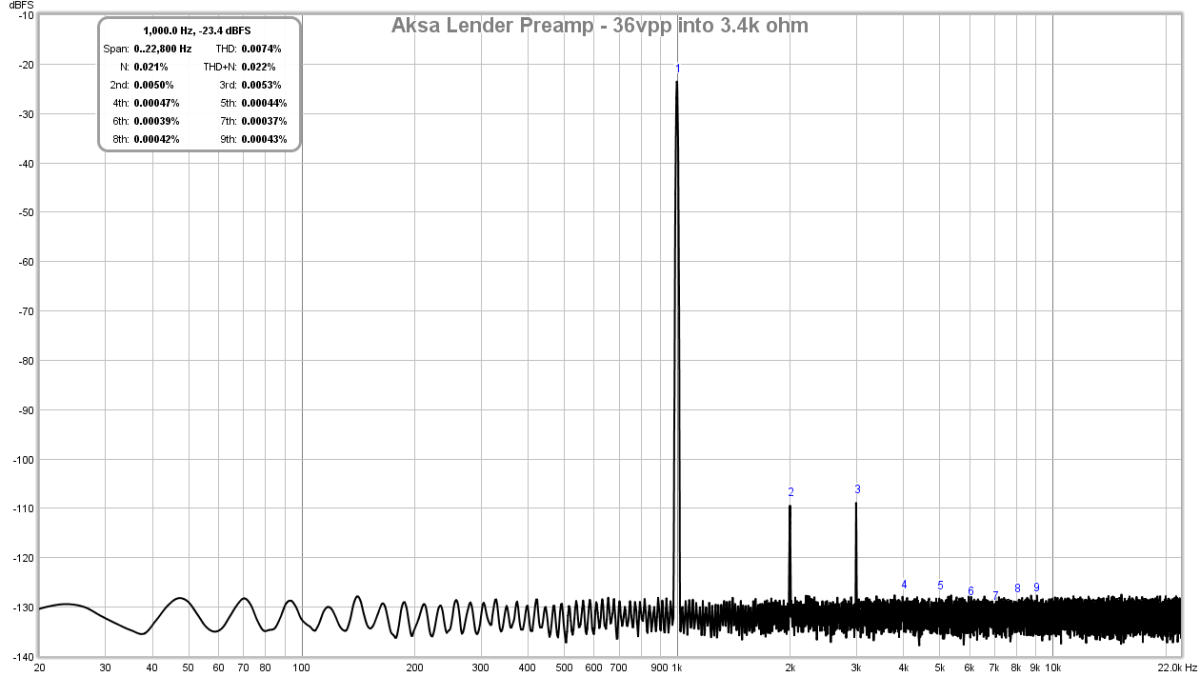
Here is IMD using DIN standard 250Hz and 8kHz at 4:1 ratio with 20vpp into 3.4kohms, IMD=0.02%:
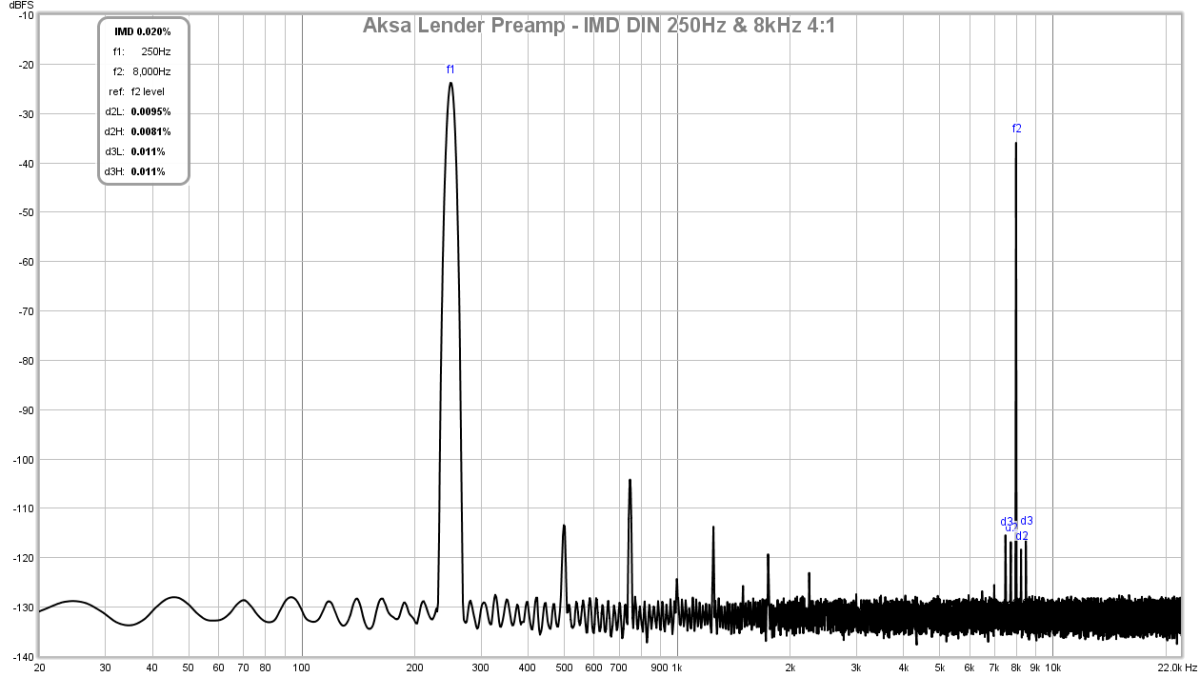
Here is IMD with same DIN standard but for 20vpp into 25kohm, IMD=0.01%:

So, I would say that 4.7k ohm load can work, just be careful of clipping at higher drive levels.
I installed a 4k7 resistor, and that, coupled with a voltage divider for the input resulted in a net 3.4kohm load.
Here is 4vpp into 3.4kohms, I adjusted the gain on the audio interface a bit but distortion is still pretty low, around noise floor of measurement setup:
Here is 20vpp into 3.4kohms, it seems 3rd order harmonic distortion increases relative to 2nd order at this loading, but still a decent result that would probably sound quite good still:
Here is 36vpp into 3.4kohms, 2nd and 3rd order about the same (some people like this sound as it has more bite), and any higher in amplitude, and it starts clipping:
Here is IMD using DIN standard 250Hz and 8kHz at 4:1 ratio with 20vpp into 3.4kohms, IMD=0.02%:
Here is IMD with same DIN standard but for 20vpp into 25kohm, IMD=0.01%:
So, I would say that 4.7k ohm load can work, just be careful of clipping at higher drive levels.
Attachments
-
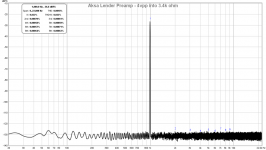 Lender-Preamp-Aksa-FFT-4.0vpp-3.4k-test-2.png79.5 KB · Views: 17,822
Lender-Preamp-Aksa-FFT-4.0vpp-3.4k-test-2.png79.5 KB · Views: 17,822 -
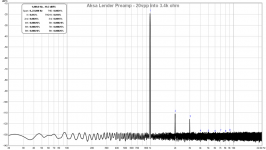 Lender-Preamp-Aksa-FFT-20vpp-3.4k-test-2.png80.5 KB · Views: 19,511
Lender-Preamp-Aksa-FFT-20vpp-3.4k-test-2.png80.5 KB · Views: 19,511 -
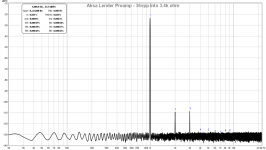 Lender-Preamp-Aksa-FFT-36vpp-3.4k-test-2.png82.5 KB · Views: 15,360
Lender-Preamp-Aksa-FFT-36vpp-3.4k-test-2.png82.5 KB · Views: 15,360 -
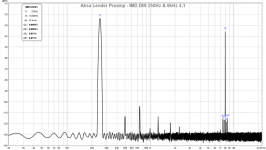 Lender-Preamp-Aksa-IMD-20vpp-3.4k-test-2.png81.6 KB · Views: 15,310
Lender-Preamp-Aksa-IMD-20vpp-3.4k-test-2.png81.6 KB · Views: 15,310 -
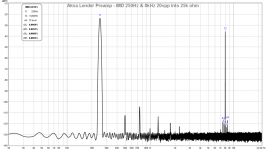 Lender-Preamp-Aksa-IMD-20vpp-25k-test-2.png83.4 KB · Views: 206
Lender-Preamp-Aksa-IMD-20vpp-25k-test-2.png83.4 KB · Views: 206
Last edited:
Yes, heresy, and I've never understood why every one believes the THD wars.......
Some say a very good SET amp does up to 1-2% and yet it's the best......
Others say a JLH SS Class A in quasi and 0.05% THD is very good too......
But I say we are chasing the wrong numbers based entirely of a real world, subjective listening experience. How do we measure depth of image, and engagement of the music?Bah, can't measure it, doesn't exist!! Hmmmm.........

We need to look forward beyond the THD, a gross sum of tiny misdemeanors, and examine the proportions of the harmonics...... and further more, how the amp manages intermodulation........
Nasty 30C day in Melbourne, not enjoying it.
HD
Almost all agree.
My priority now when design an amplifier is enough slew rate (as high as possible, but still stable), good distortion harmonic profile, good PSRR, and the last is THD. But when we can make THD small enough, why not?
In my experience, most people sensitive from response frequency and damping factor. But only training people can differentiate small distortion and it more difficult to do it in high SPL.
Fantastic measurements, X, thank you!
HD
What do you think of the IMD performance? I do not know what a "good" measurement is. Is 0.01% IMD for 250Hz and 8kHz a good figure?
One more measurement, this is Wayne Kirkwood's THAT1646 HPA (0dB gain current buffer), which up to this point, was the lowest distortion amp I had measured. But subjecting it to the same 4.7kohm load and 4vpp, I get the following distortion with a THD of 0.0022%, a low number, but Hugh's Lender preamp actually beats a formidable low distortion opamp in this case! Here is the Kirkwood THAT1646 driving 4vpp into 4.7koms:
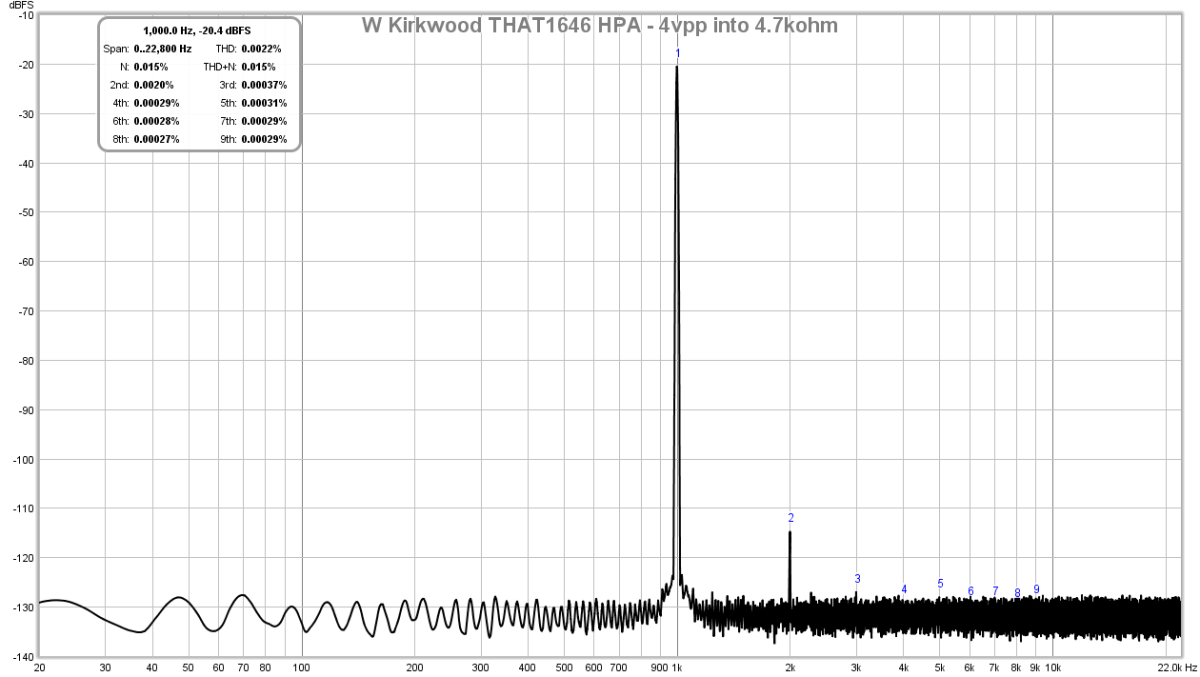
So the AKSA Lender Preamp, now has the new distinction of being the lowest distortion amp I have measured for a 4.7kohm impedance at 4vpp.
Using the Kirkwood THAT1646 as a headphone amp driving a 51ohm load, we see that the dominant distortion is now 3rd order:
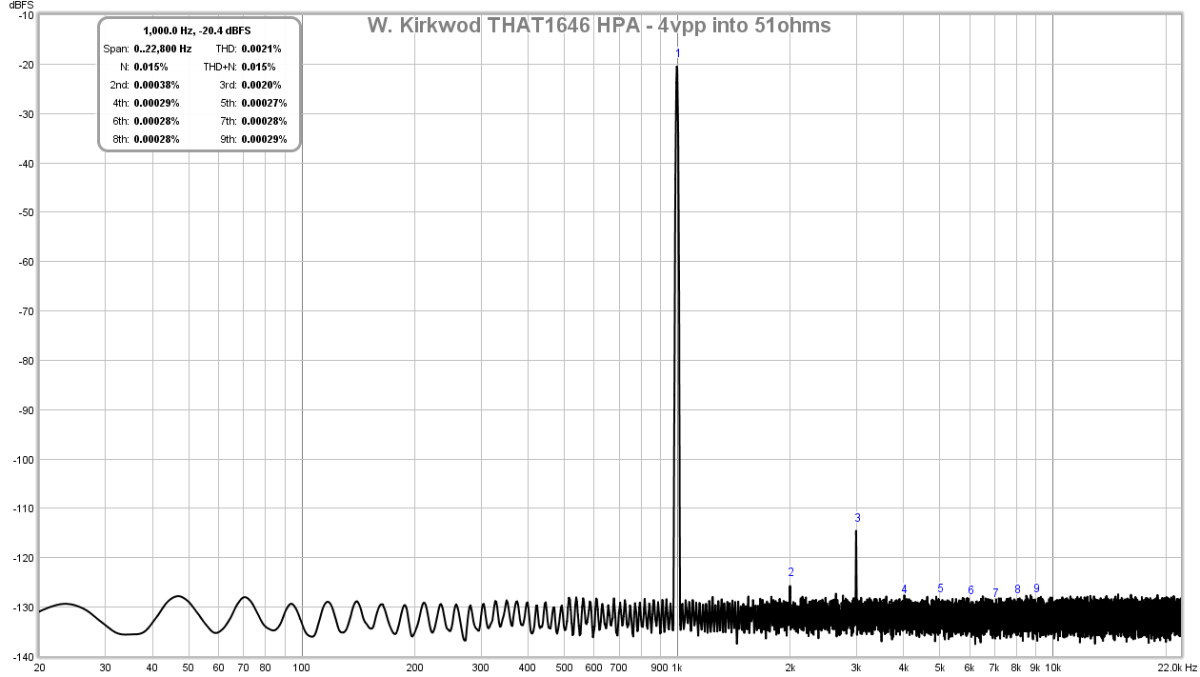
It's not a bad headphone amp, but doesn't have the nice harmonic profile of a SE Class A amp.
So the AKSA Lender Preamp, now has the new distinction of being the lowest distortion amp I have measured for a 4.7kohm impedance at 4vpp.
Using the Kirkwood THAT1646 as a headphone amp driving a 51ohm load, we see that the dominant distortion is now 3rd order:
It's not a bad headphone amp, but doesn't have the nice harmonic profile of a SE Class A amp.
Attachments
Last edited:
Hi xrk,may i ask what is your measurement hardware and software?One more measurement, this is Wayne Kirkwood's THAT1646 HPA (0dB gain current buffer), which up to this point, was the lowest distortion amp I had measured. But subjecting it to the same 4.7kohm load and 4vpp, I get the following distortion:

With a THD of 0.0022%, a low number, but Hugh's Lender preamp actually beats a formidable low distortion opamp in this case! Here is the Kirkwood THAT1646 driving 4vpp into 4.7koms:

So the AKSA Lender Preamp, now has the new distinction of being the lowest distortion amp I have measured for a 4.7kohm impedance at 4vpp.
Using the Kirkwood THAT1646 as a headphone amp driving a 51ohm load, we see that the dominant distortion is now 3rd order:

It's not a bad headphone amp, but doesn't have the nice harmonic profile of a SE Class A amp.
Regards.
Careful XRK. A comparison like that might invoke a contest. I know there are many here who can handily beat those numbers. If you want something to measure infinitely good, just ask. Whatever circuit you post, there are probably several ways to "improve" it.
Right, I was only referring to my own measurement as I previously stated that the THAT1646 HPA that I built was the lowest distortion amp that I had measured, and now it turns out, Hugh's design is actually lower (as a preamp). I fully realize there are designs out there with qnty 248+ actives that achieve order of 1ppb (part per billion) THD
Hi xrk,may i ask what is your measurement hardware and software?
Regards.
Hi Thimios,
I am using a Focusrite USB ADC/DAC (audio interface). I have 3 units, all using the same ADC/DAC internally, I think. These are the Solo 2nd gen, the 2i2 2nd gen, and the 2i4 2nd gen. The data for this preamp was taken with a 2i4 and the Solo. The software is REW, in RTA mode with the built in function generator feeding the DAC. I typically run in ASIO mode at 48kHz data rate. Sometimes I use Right Mark Audio Analyzer, but I find that too limiting as it requires one to set the amplitude exactly at a certain level before it agrees to acquire data. Whereas REW, takes data always, no matter what. For signals greater than 3 or 4v, I use a 10:1 voltage divider network. The one limitation that I have just run into is that the noise floor on the Focusrite is -130dB, and some amps actually have a lower distortion level than this, or of same order of magnitude. But generally, that won't matter anyway as it is much too low to really matter. Oh, it helps to have a lot of RCA to 3.5mm stereo cables, or RCA to alligator clip cables, and several 3.5mm and 1/4in stereo jacks fitted with dummy load resistors.
Cheers,
X
Last edited:
X,
I struggle with IMD. I don't measure too much these days; I place huge emphasis on critical listening, and I find orchestras at high level very useful. I have seen useful tests with 18KHz and 19KHz, the higher say 20dB down. The many harmonics of this are useful. I don't push slew rate too much; anything over about 10V/uS for a 100W amp is enough in the audio band. Making it too high, or reducing THD too much, indicates a lot of global feedback and in my experience seems to flat the sound field to 2D. Depth is quite sensitive to high global feedback, and to this end, compensation is crucial.
I do try to use single ended front ends, I do not like symmetrical input stages. They tend to depress even harmonics, and bring out the odds. SE topologies bring up evens, particularly H2 and H4, and usually bring much more THD in as well, but it's not 'machine' tones, like H5, H7 etc.
Hugh
I struggle with IMD. I don't measure too much these days; I place huge emphasis on critical listening, and I find orchestras at high level very useful. I have seen useful tests with 18KHz and 19KHz, the higher say 20dB down. The many harmonics of this are useful. I don't push slew rate too much; anything over about 10V/uS for a 100W amp is enough in the audio band. Making it too high, or reducing THD too much, indicates a lot of global feedback and in my experience seems to flat the sound field to 2D. Depth is quite sensitive to high global feedback, and to this end, compensation is crucial.
I do try to use single ended front ends, I do not like symmetrical input stages. They tend to depress even harmonics, and bring out the odds. SE topologies bring up evens, particularly H2 and H4, and usually bring much more THD in as well, but it's not 'machine' tones, like H5, H7 etc.
Hugh
Off topic
I listen to a lot of orchestral music (very well recorded and performed) from a second hand (I was not afraid to experiment and break the warranty) AV Marantz SR4500 to which I have greatly improved the original sound.
Marantz SR4500 A/V Receiver HT Labs Measures | Sound & Vision
I have wanted to change it for a long time but I have always believed that a high slew-rate was better for orchestras. Am I wrong?
X,
I don't push slew rate too much; anything over about 10V/uS for a 100W amp is enough in the audio band...
I do try to use single ended front ends, I do not like symmetrical input stages. They tend to depress even harmonics, and bring out the odds. SE topologies bring up evens, particularly H2 and H4, and usually bring much more THD in as well, but it's not 'machine' tones, like H5, H7 etc.
Hugh
I listen to a lot of orchestral music (very well recorded and performed) from a second hand (I was not afraid to experiment and break the warranty) AV Marantz SR4500 to which I have greatly improved the original sound.
Marantz SR4500 A/V Receiver HT Labs Measures | Sound & Vision
I have wanted to change it for a long time but I have always believed that a high slew-rate was better for orchestras. Am I wrong?
- Home
- Source & Line
- Analog Line Level
- AKSA's Lender Preamp with 40Vpp Output
